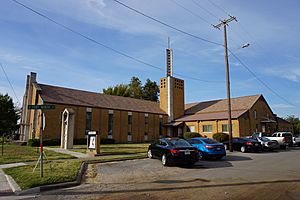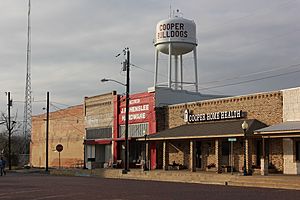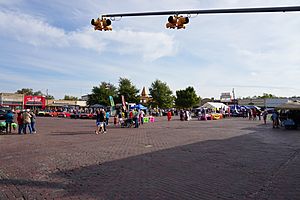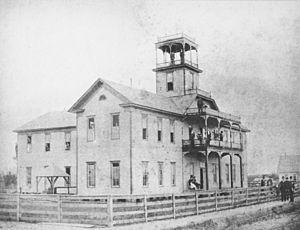Cooper, Texas facts for kids
Quick facts for kids
Cooper, Texas
|
|
|---|---|
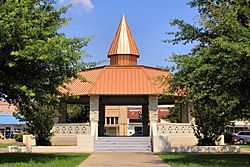
The gazebo on the square in downtown Cooper
|
|
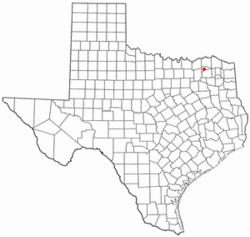
Location of Cooper, Texas
|
|
 |
|
| Country | |
| State | |
| County | Delta |
| Founded | 1870 |
| Named for | Leroy Cooper |
| Area | |
| • Total | 1.47 sq mi (3.80 km2) |
| • Land | 1.46 sq mi (3.79 km2) |
| • Water | 0.01 sq mi (0.01 km2) |
| Elevation | 482 ft (147 m) |
| Population
(2020)
|
|
| • Total | 1,911 |
| • Density | 1,300/sq mi (502.9/km2) |
| Time zone | UTC-6 (Central (CST)) |
| • Summer (DST) | UTC-5 (CDT) |
| ZIP code |
75432
|
| Area code(s) | 903, 430 |
| FIPS code | 48-16564 |
| GNIS feature ID | 2410222 |
Cooper is a city in Texas, and it's the main town of Delta County. It's located between the north and south parts of the Sulphur River. Cooper is the biggest town in Delta County. In 2020, about 1,911 people lived there.
Native people first lived in this area. Cooper was started around 1870, when Delta County was also created. The city grew quickly and became important for local events. Its economy mainly depended on farming and shipping goods. In the mid-1890s, a railroad line was built through Cooper, which helped it grow even more.
The city kept growing until the early 1920s. But in 1926, the region's cotton crops failed. This hurt the local economy badly. Many businesses closed, including the railroad, and the city's population dropped. Cooper started to get better in the mid-1930s, but many people who left never came back.
The local economy still relied on growing cotton until the 1960s. Then, in the early 1970s, it started to shift to growing wheat. Cooper's population has slowly gone down since the 1970s.
Cooper doesn't have any places listed on the National Register of Historic Places. The city's economy still mostly depends on farming. Cooper is on the eastern edge of the Dallas–Fort Worth metroplex, which is a very large area with many people.
Contents
History of Cooper, Texas
Early Inhabitants and Founding
The first people to live where Cooper is now were the Caddo Indians. They settled in eastern Texas around 800 CE. The Caddo were skilled farmers and lived in big wooden homes. A French explorer named François Hervey visited the area around 1750.
Later, European diseases and attacks from other tribes forced the Caddo to leave. Around 1820, other tribes like the Delaware, Quapaw, and Seminole settled there. In 1836, the area became part of Red River County. Over the next few decades, it became part of Lamar County and then Hopkins County.
After the American Civil War, the area around Cooper began to develop. People wanted a new county because the roads were bad. In 1868, they asked the state government to create a new county between the north and south parts of the Sulphur River. On July 29, 1870, Texas agreed to create the new county.
Soon after, the first buildings were put up in Cooper, and the town was started. It was named after Leroy Cooper, who helped create the new county. Cooper was chosen as the county seat for Delta County, which got its name because it's shaped like a triangle.
Growth and Challenges in Cooper
Cooper grew quickly after it was founded. A post office was built in 1871. Cooper became an official town in 1881 and held its first elections. That same year, the county courthouse was built. By 1885, Cooper had about 300 people and was the main market for Delta County.
The Texas Midland Railroad was built through Cooper in 1892. This railroad helped the town grow even faster. By 1896, Cooper's population was over 1,000. It had two churches, a school, and 21 businesses, including a bank and a hotel. The town also had two weekly newspapers.
Cooper continued to grow into the early 1900s, especially in farming. From the 1890s to about 1910, farms became much more valuable. The number of crops grown for sale almost tripled. The region produced many chickens and pigs each year.
The town kept growing into the 1920s. The bank was rebuilt in 1909, and crops continued to do well. In 1925, Cooper had its largest population ever, with 2,563 people. However, Delta County was hit hard by the Great Depression early on. In late 1926, the cotton crop failed. This forced many people to take out their savings.
The bank closed in 1927. Even though it reopened a few months later, the economy had crashed. Many families moved away from Cooper in the early 1930s. In 1933, the bank had to close again. The Midland Texas Railroad also failed, which hurt Cooper's economy even more.
The New Deal program helped by funding construction projects in Cooper. In 1940, the Works Progress Administration built a new courthouse. Even with the economy getting better, Cooper's population stayed low until the 1950s. It then went back up to about 2,350 people.
The population declined again in the 1980s and has continued to slowly drop. In the 1970s and 1980s, Cooper had about 60 businesses. Work on Cooper Lake began in 1986. The lake started filling in September 1991 and opened for fun activities the next year. At that time, Cooper had 70 businesses and about 2,200 people. By 2000, the population had dropped slightly.
Geography of Cooper
Cooper is the main town and the most populated city in Delta County. It covers about 1.5 square miles (3.8 km2). Most of this area is land, with a small part covered by water.
Cooper is about 482 feet (147 m) above sea level. It's a few miles north of Cooper Lake, between the north and south parts of the Sulphur River. The city is about 76 miles (122 km) northeast of Dallas and 94 miles (151 km) west of Texarkana.
Texas State Highway 24 goes around Cooper to the north. However, a smaller road called Texas State Highway 24 Business goes through the center of the city. Texas State Highway 154 starts on the west side of Cooper and also goes through the middle of town. It crosses Farm to Market Road 1528 near the courthouse. Farm to Market Road 64 enters the far western part of Cooper before ending at State Highway 24. Other nearby roads include Farm to Market Road 1880 and Farm to Market Road 1529.
Cooper is in the Texas Blackland Prairies region. This area is mostly flat, with tall grass. The ground is mainly deep clay or clay mixed with dark soil. This soil is very good for growing crops.
Climate in Cooper
Cooper has a humid subtropical climate. This means it has warm, wet summers. The average temperature in January is about 43°F (6°C). In July, it's about 92°F (33°C).
The hottest temperature ever recorded in Cooper was 115°F (46°C) in 1969. The coldest was -4°F (-20°C) in 1989. October is usually the wettest month. January is the coolest, and August is the hottest.
| Climate data for Cooper, Texas | |||||||||||||
|---|---|---|---|---|---|---|---|---|---|---|---|---|---|
| Month | Jan | Feb | Mar | Apr | May | Jun | Jul | Aug | Sep | Oct | Nov | Dec | Year |
| Record high °F (°C) | 85 (29) |
91 (33) |
91 (33) |
93 (34) |
99 (37) |
107 (42) |
111 (44) |
115 (46) |
112 (44) |
100 (38) |
89 (32) |
85 (29) |
115 (46) |
| Mean daily maximum °F (°C) | 53 (12) |
57 (14) |
65 (18) |
73 (23) |
80 (27) |
87 (31) |
92 (33) |
93 (34) |
86 (30) |
75 (24) |
64 (18) |
54 (12) |
73 (23) |
| Mean daily minimum °F (°C) | 33 (1) |
37 (3) |
44 (7) |
52 (11) |
61 (16) |
69 (21) |
73 (23) |
72 (22) |
64 (18) |
53 (12) |
44 (7) |
34 (1) |
53 (12) |
| Record low °F (°C) | 0 (−18) |
−1 (−18) |
11 (−12) |
27 (−3) |
36 (2) |
48 (9) |
53 (12) |
49 (9) |
39 (4) |
23 (−5) |
14 (−10) |
−4 (−20) |
−4 (−20) |
| Average precipitation inches (mm) | 3.0 (76) |
3.8 (97) |
4.4 (110) |
3.8 (97) |
4.8 (120) |
4.4 (110) |
3.4 (86) |
2.4 (61) |
3.0 (76) |
5.4 (140) |
4.5 (110) |
4.3 (110) |
47.2 (1,193) |
People of Cooper
| Historical population | |||
|---|---|---|---|
| Census | Pop. | %± | |
| 1880 | 294 | — | |
| 1890 | 629 | 113.9% | |
| 1900 | 1,518 | 141.3% | |
| 1910 | 1,513 | −0.3% | |
| 1920 | 2,563 | 69.4% | |
| 1930 | 2,023 | −21.1% | |
| 1940 | 2,537 | 25.4% | |
| 1950 | 2,350 | −7.4% | |
| 1960 | 2,213 | −5.8% | |
| 1970 | 2,258 | 2.0% | |
| 1980 | 2,338 | 3.5% | |
| 1990 | 2,153 | −7.9% | |
| 2000 | 2,150 | −0.1% | |
| 2010 | 1,969 | −8.4% | |
| 2020 | 1,911 | −2.9% | |
| Race | Number | Percentage |
|---|---|---|
| White (NH) | 1,395 | 73.0% |
| Black or African American (NH) | 253 | 13.24% |
| Native American or Alaska Native (NH) | 7 | 0.37% |
| Asian (NH) | 23 | 1.2% |
| Pacific Islander (NH) | 4 | 0.21% |
| Some Other Race (NH) | 12 | 0.63% |
| Mixed/Multi-Racial (NH) | 57 | 2.98% |
| Hispanic or Latino | 160 | 8.37% |
| Total | 1,911 |
In 2010, Cooper had 1,969 people. There were 771 households and 897 housing units. This was a 56.6% increase from 2000. In 2010, most people in Cooper were White (77.2%). There were also African American (14.8%), Native American (1.2%), Asian (1.1%), and other races (2.8%). About 6.1% of the people were Hispanic or Latino.
By 2020, the population dropped to 1,911. Most people were still non-Hispanic White. The town also had African American, Native American, Asian, and multiracial residents. About 6.0% of the population was Hispanic or Latino.
In 2010, about 27.9% of households had children under 18. Many households (64.9%) were married couples. About 31.5% of households had only one person living there. The average household had 2.46 people. The average family had 3.09 people.
The median age in Cooper was 40.2 years. This means half the people were older than 40.2, and half were younger. The median household income was $27,531. By 2020, this income went up to $36,458.
Religion in Cooper
The first church in the area was built in 1847 by pioneers. By 1860, two Methodist churches were nearby. In 1880, Delta County had seven churches, mostly Methodist. In 1889, seven Baptist churches in the region held a meeting together.
In the early 1980s, Delta County had 17 churches, with two in Cooper. By 1931, there were 13 Baptist churches in and around Cooper. In the mid-1960s, the region had 32 churches from seven different Christian groups. However, five of those churches closed by 1982.
Today, Cooper has 18 churches. These include churches from the United Methodist Church and the Seventh-day Adventist Church. There are also Baptist, Catholic, Pentecostal, and other Christian churches. Six of the churches are Baptist, and three are Methodist.
Economy of Cooper
Cooper's economy relied heavily on farming from its start until the 1950s. They especially grew cash crops, which are crops grown to be sold. In 1880, farmers grew cotton, corn, and other crops on over 100,000 acres (40,000 ha). The county also raised many animals like cattle and hogs.
The logging industry also grew, and several mills were built to make furniture and lumber. In 1886, the Santa Fe Railway built a line through the county. Shipping crops and lumber became a big business in Cooper.
In the early 1890s, raising animals became harder. But farming boomed, with many more farms around Cooper. The value of farms doubled. Cotton production tripled, and the chicken farming business grew a lot.
Inside Cooper, there was a hotel, a shoemaker, grocery stores, and places to process cotton and oats. Delta County had 18 factories, but they only employed 33 people. The average income for a worker was about $208.
At the start of the 1900s, the cotton industry was booming. Cotton made up 69% of the farming business. Raising animals and chickens was also doing very well. Shipping farm goods and animals was another main business. The First National Bank was rebuilt in 1909 and became important for Cooper's economy.
In the 1910s, potatoes became important because the animal farming business dropped. In 1926, the cotton crop failed, and Cooper's economy crashed. Many people in Cooper went into debt as crop prices fell. Lumber businesses closed because they had used up all the trees. Many people moved away to find new jobs.
The local economy got better in the mid-1930s. Cotton, potato, and corn production started to rise again. However, the railroad through Cooper had failed, so shipping was difficult. Cotton and alfalfa kept Cooper's economy going through the 1950s and 1960s. Then, in the 1970s, farmers started growing more wheat.
In the 1970s, Cooper had 60 businesses, and more than half were dairies. In the 1980s and 1990s, Cooper's economy shifted to making and shipping local goods. In 1991, Cooper had 70 businesses.
Today, Cooper's economy has several industries. In 2010, many people worked in education, health, and social services (34.6%). Manufacturing was also big (18.7%). Other jobs were in arts, entertainment, construction, transportation, and public service.
About 49.3% of the people over 16 were working. About 5.1% of people were unemployed. Most employed people (78.0%) worked for private companies. Some worked for the government (17.9%), and a few were self-employed (4.1%).
Fun Things to Do in Cooper
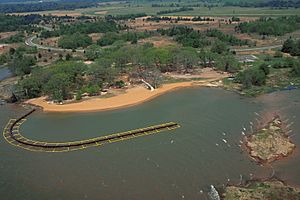
Since it was founded, Cooper has been a center for fun in Delta County. The city has small schools and churches. In 1955, plans for Cooper Lake were approved. Big work on the lake started in 1986 and finished in 1991.
Today, Cooper Lake is the most popular place to visit in the area. You can go boating, swimming, and fishing there. The main fish in the lake are catfish, largemouth bass, and crappie.
Along the north side of the lake is the Doctor's Creek Unit of Cooper Lake State Park. This park has picnic areas, campgrounds, and a large swimming spot on the lake. It also has trails for hiking and horseback riding. On the east side of the lake, there's a Wildlife Observation Deck for watching birds.
On the west and northwest sides of the lake is the Cooper Wildlife Management Area. This park was built by the U.S. Army Corps of Engineers. It protects four types of natural areas: wetlands, Blackland Prairie, Upland Post Oak, and Bottomland Hardwood. The park has hiking trails, birdwatching spots, and places to see wildlife. You can also fish and hunt there if you have a license.
Cooper also hosts an event called Chiggerfest every October. It's a fun gathering for the region. The two-day event starts with an outdoor concert in Historic Cooper Square. Other activities include a 5K run/walk and smashing a car. The festival has many street vendors and a special area for children.
The Patterson Memorial County Library is in Cooper. There's also a 15-acre (6.1 ha) city park. Cooper has many recreation and community centers, including the historic McKinney Home. This house was built in 1912 and later fixed up by a family member.
Education in Cooper
Delta County has always focused on education. Around the time Cooper was founded, there were already nine schools in the county. By 1880, this number grew to almost 30 schools. Nearly 1,000 students attended these schools, which were open for about 4½ months a year.
In 1889, East Texas Normal College was started in Cooper. The school did very well there. But in 1894, the campus was destroyed in a fire, and the college moved to Commerce. This school was later renamed East Texas State University, and then Texas A&M University–Commerce. In 1896, Cooper had one successful school within the city.
Schools were important activity centers in the 1940s. In the early 1940s, Delta County had 34 smaller schools and six larger school districts. These schools had 134 staff members and about 4,000 students. Cooper, along with Pecan Gap and Enloe, offered a four-year high school program. Later in the 1940s, schools and districts started to combine. By 1966, Cooper had two elementary schools, a junior high, and a high school.
The Cooper Independent School District (Cooper ISD) runs the schools in Cooper today. Cooper ISD covers most of Delta County. There are currently three schools in Cooper ISD, all located in Cooper: Cooper Elementary School, Cooper Junior High School, and Cooper High School.
Media in Cooper
The first newspaper in Cooper was the Delta Courier, started in 1873. It was published weekly until the mid-1890s. After that, the People's Cause newspaper began running weekly, but it also stopped later. The Cooper Review started weekly in 1982 and is still published today.
Transportation in Cooper
Texas State Highway 154 (TX 154) goes through the middle of Cooper. It starts on the west side of Cooper and travels east through the city. It then turns southeast and leaves the city. TX 154 runs for about 1.94 miles (3.12 km) within Cooper. This highway was first built through Cooper on September 26, 1935.
State Highway 24 is a four-lane highway that goes around Cooper. Only about 0.48 miles (0.77 km) of this highway pass through the western edge of the city. TX 24 was originally planned to go through Cooper in 1939. However, it was later rerouted around the city. In 1991, the 1.94-mile (3.12 km) part of the old highway was renamed Texas State Highway 24 Business.
Farm to Market Road 64 (FM 64) enters the western part of Cooper and travels a short distance before ending at TX 154. This road, built in 1942, is about 0.41 miles (0.66 km) long within the city. FM 1528, also known as 1st Street, goes through the center of Cooper. It starts at TX 154 and travels south for about 0.6 miles (0.97 km) before leaving the city. This road was built in 1949.
Other nearby roads include FM 1880, which goes to part of the Cooper Lake Wildlife Management Area. FM 128 ends at TX 24 north of Cooper. FM 1529 goes north a short distance east of the city.
In 1886, the Santa Fe Railroad was built north of Cooper. About ten years later, in 1895, the Texas Midland Railroad was built through Cooper. This helped the city's economy grow a lot. The train station that still stands today was built in 1913. The railroad did well until 1928, when it was sold because the region's economy was struggling. The line closed in 1934 and was completely abandoned in 1975.
Today, the only railroad that passes near Cooper is the Blacklands Railroad. The closest airport to Cooper is Commerce Municipal Airport, which is about 13 miles (21 km) away.
Famous Person from Cooper
- Ron Morris, a former professional American football wide receiver. He played for the Chicago Bears for six seasons.
See also
 In Spanish: Cooper (Texas) para niños
In Spanish: Cooper (Texas) para niños


